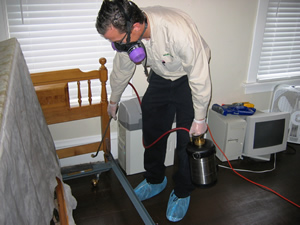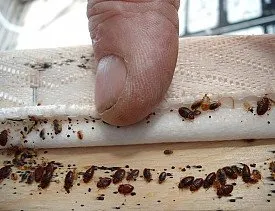Economical Bed Bug Exterminator Near Me: DC Heat Treatment Specialists
Economical Bed Bug Exterminator Near Me: DC Heat Treatment Specialists
Blog Article
Exploring the Scientific Research Behind Bed Bug Warm Treatments as a Sustainable Bug Management Method
In the realm of parasite management, the pursuit for sustainable and efficient options remains a continuous search. One such technique that has actually gained grip in current years is the use of warmth treatments to deal with bed pest infestations. By utilizing the scientific research behind thermal death points for these consistent pests, heat therapies supply a promising option to typical chemical-based methods. The ins and outs of just how warmth efficiently gets rid of bed pests and the more comprehensive implications for sustainable bug monitoring techniques make this a topic worth exploring additionally.
Bed Pest Warmth Therapy Refine

Thermal Fatality Factor for Bed Pests
Subjecting bed pests to elevated temperature levels beyond their thermal resistance variety is essential for attaining efficient obliteration in heat treatment procedures. The thermal death point for bed pests refers to the temperature level at which these pests can not make it through. Study indicates that bed pests start to perish when revealed to temperatures above 113 ° F(45 ° C) for a continual period. As the temperature raises, so does the mortality rate of bed insects. At around 118 ° F(48 ° C ), bed bugs begin to pass away swiftly, with a mortality rate of virtually 99% within minutes of exposure. This shows the level of sensitivity of bed bugs to heats and highlights the effectiveness of warm therapies in eradicating invasions. By getting to and keeping temperatures above the thermal fatality point for bed insects, bug monitoring experts can ensure detailed removal of bed pest populaces, including hard-to-reach areas where chemical treatments may be less efficient. Recognizing the thermal death point for bed bugs is necessary for applying successful heat treatment techniques and accomplishing sustainable bug monitoring end results.
Benefits of Warmth Treatments
Having established the crucial thermal fatality factor for bed insects, it is imperative to now discover the significant advantages that warmth treatments provide in properly eradicating these durable parasites. One of the primary advantages is that warm can pass through deep into holes and cracks where bed bugs hide, making sure that also the most hard-to-reach areas are heated to deadly temperature levels.
In addition, warmth treatments are ecologically pleasant and safe, making them a lasting parasite management technique. Unlike chemical pesticides, warm treatments do not leave dangerous deposits that can posture threats to human health or the environment. This aspect is particularly essential in sensitive atmospheres such as healthcare facilities, colleges, and houses where chemical usage might not be preferable.
Furthermore, warm treatments have a high success rate in eliminating bed bug infestations in a single therapy, lowering the demand for numerous sees and lessening disruption to occupants. This performance not just conserves time and money however also provides satisfaction to those managing bed insect issues.
Effectiveness of Heat Therapy

Research study researches have consistently shown the effectiveness of warm therapies in accomplishing a high go to my blog price of bed insect death. Correctly performed warm therapies can reach all the gaps and splits where bed pests may be nurturing, ensuring a detailed approach to elimination. Warmth treatments have the included advantage of killing bed bug eggs, which are usually resistant to conventional chemical therapies. Overall, the efficiency of warm therapies in eradicating bed insect invasions makes them a sustainable and trustworthy parasite management technique.
Sustainable Pest Monitoring Conveniences
Executing sustainable pest monitoring techniques uses lasting advantages for both the environment and public health. By making use of techniques such as heat treatments for parasite control, we can minimize the reliance on harmful chemical pesticides that can have adverse results on environments and human health and wellness - exterminator near me. Lasting bug administration strategies aid in protecting biodiversity by targeting specific bugs without harming non-target microorganisms, consequently maintaining a well balanced community
Furthermore, sustainable pest administration practices add to the overall health and wellness and well-being of the public. By minimizing exposure to poisonous chemicals utilized in typical find out here now insect control approaches, warm therapies offer a more secure alternative for bug monitoring in domestic, business, and public spaces. This reduction in chemical use also assists in protecting against pesticide residues from polluting air, soil, and water, guarding environmental high quality.
Verdict
In conclusion, bed insect warm therapies have been shown to be a efficient and lasting insect administration approach. The thermal fatality point for bed bugs makes them vulnerable to warm therapies, which have countless advantages over conventional chemical treatments. The efficiency of warm therapies in removing bed pest problems while minimizing environmental effect highlights the possibility of this approach as a lasting remedy for pest control.
The bed bug heat treatment process involves raising the temperature within infested areas to a degree that effectively eliminates bed bugs and their eggs. By reaching and maintaining temperatures above the thermal death factor for bed pests, parasite monitoring professionals can ensure comprehensive elimination of bed insect populations, including hard-to-reach areas where chemical therapies might be less efficient. One of the primary advantages is that warm can pass see post through deep into splits and crevices where bed pests hide, ensuring that also the most hard-to-reach locations are warmed to dangerous temperatures. Unlike chemical treatments that might leave behind resistant populaces, warm treatments offer a safe and eco friendly service that can penetrate deep right into furniture, walls, and various other hard-to-reach areas where bed bugs conceal.
The thermal death factor for bed insects makes them vulnerable to warmth therapies, which have various benefits over standard chemical treatments.
Report this page